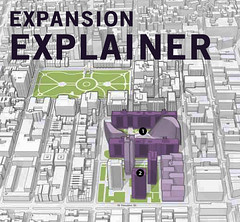An eclectic group of musicians – including Gordon Gano belting out his Violent Femmes classic “Blister in the Sun” – performed last night at a benefit to “put a stop to this destructive, environmentally calamitous process that’s destroying the city we all love.” At least, that’s how the evening’s M.C., Mark Crispin Miller of Faculty Against the Sexton Plan, put it shortly before announcing that Susan Sarandon and Matthew Broderick were among those who pledged money to a lawsuit against N.Y.U.’s expansion plans.
The idea behind the “Save the Village” concert at Le Poisson Rouge, Mr. Miller told an audience of about 200, was to show that the Village still rocks – even if “N.Y.U. does not rock. N.Y.U. rolls. It rolls its students; it rolls its faculty; it rolled the City Council. We’ve got to stop this.”
To that end, songstress Janine Nichols kicked off the night by cooing “This Land Is Your Land” with John Kruth on sitar. (It was that kind of evening: bongos, banjos, cowbells, canastas, and, yes, even scatting. At times the Greenwich Village club resembled a genuine Beat coffee shop.)
Noise rocker Thurston Moore of Sonic Youth got right into it with composer and saxophonist John Zorn. The duo launched into a cacophany of discordant free jazz that had all the abrasiveness of, well, jackhammering south of Washington Square Park. Read more…
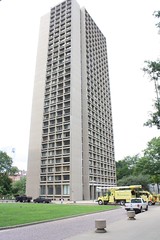 Melvin Felix 505 LaGuardia
Melvin Felix 505 LaGuardiaNew York University has reached an agreement with the co-op board at 505 LaGuardia that will prevent dramatic rent hikes at the building. The new agreement extends the current lease in perpetuity, as long as the building remains part of the Mitchell-Lama affordable housing program.
The building’s previous lease was due to expire in 2014 after standing for 50 years. Terms of the new lease became a sticking point in the negotiations surrounding the university’s expansion, even though the building itself would not be affected. Politicians including Borough President Scott Stringer, Congressman Jerrold Nadler, and State Senator Thomas Duane had repeatedly called for the university to come to an agreement with 505 LaGuardia that would avoid rent hikes at the 30-story towers designed by James Freed and I.M. Pei.
Today, N.Y.U. described the agreement, the specific terms of which were not released, as a reflection of the university’s commitment to affordable housing. Read more…
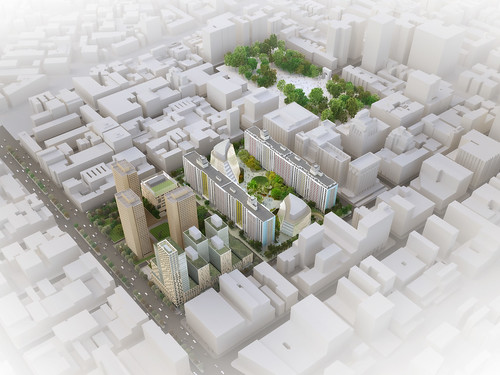 Courtesy of N.Y.U. A rendering of N.Y.U.’s plans for two blocks south of Washington Square Park that features the newly reduced buildings.
Courtesy of N.Y.U. A rendering of N.Y.U.’s plans for two blocks south of Washington Square Park that features the newly reduced buildings.Opponents of N.Y.U.’s expansion are hinting that they will announce new legal maneuvers to derail the project should it be approved the City Council tomorrow as expected.
An e-mail from the Greenwich Village Society for Historic Preservation notes that lawyers representing faculty opposed to the plan will speak tomorrow after the vote at City Hill “regarding their next steps.” Those opponents have long spoken about the possibility of challenging the land-use review process in court.
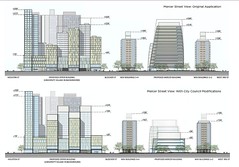 N.Y.U. A slide depicting the reduction of building’s in
N.Y.U. A slide depicting the reduction of building’s in
the proposed project footprint.The executive director of the Greenwich Village Society, Andrew Berman, would not comment on the organization’s specific legal plans until tomorrow, but added, “Should they vote to approve this plan, we and our partners on the N.Y.U. faculty will be working closely with our counsel, Gibson Dunn, to look at every remedy available to right this wrong.” Read more…
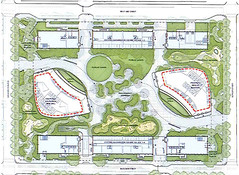 N.Y.U. Red lines indicate the reduction of the boomerang
N.Y.U. Red lines indicate the reduction of the boomerang
buildings on the northern block.At a meeting attended by Rosie Mendez and Margaret Chin last night, members of Community Board 2 spoke out against the scaled-back version of N.Y.U.’s controversial expansion plan that the two City Council members supported earlier this week.
Ms. Chin said she wanted to explain the “compromise” she helped work out, which she said reduced above-ground space associated with N.Y.U. 2031 by an additional 17.4 percent, or 212,000 square feet.
The modified plan would cut the Mercer Street building from 11 stories to four, and shrink the height of towers in the Zipper Building. Over all, according to Ms. Chin’s newsletter for her district, it represents a reduction of 26 percent or 352,000 square feet from the original proposal that was certified in January.
Residents last night were clearly disappointed that the City Council’s land use committee had approved the plan by a vote of 19-1, with the Council’s subcommittee on zoning also voting in favor of it. “I know people aren’t happy,” Ms. Chin said, to sardonic laughter. “It’s a compromise. But I want you to look at what we’ve been able to achieve with density and open space, because the City Council will vote on this issue.” Read more…
 N.Y.U. Red lines indicate the reduction of the boomerang buildings on the northern block.
N.Y.U. Red lines indicate the reduction of the boomerang buildings on the northern block.A City Council committee voted in favor of New York University’s expansion plan on Tuesday following last minute negotiations that yielded several significant reductions of the project.
The land use committee’s 19-1 vote sends the plan, dubbed N.Y.U. 2031, to the full City Council, which will vote on the plans later this month. Councilwoman Margaret Chin, a member of the committee who represents Greenwich Village, took the lead in negotiations with the university and strongly urged other council members to support the modified plan.
“I wholeheartedly believe that this proposal will allow N.Y.U.’s growth in the Village to occur at a sustainable pace, and that it will not overwhelm the wider Village community,” Ms. Chin said. “Over the past few months, I have heard a litany of N.Y.U.’s broken promises from Village residents. It is time to start a new chapter.” Read more…
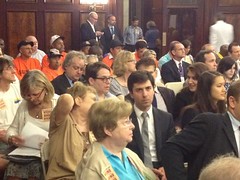 Sarah Darville Matthew Broderick, in glasses.
Sarah Darville Matthew Broderick, in glasses.The City Council hearing on New York University’s controversial expansion plan got a star cameo today, as Greenwich Village native Matthew Broderick argued that N.Y.U. 2031 would further strip the neighborhood of of its character. He was one of about 250 people who spoke out during the packed nine-hour meeting, with about 60 percent opposing the plan and 40 percent voicing their support.
Six hours before the actor testified, N.Y.U.’s president, John Sexton, started the hearing (which The Local liveblogged earlier today) by vigorously defending the project and the university’s need to expand. “This is not a development project. This is an academic project,” he said, explaining that more space was needed to recruit top-quality faculty and students.
Asked why N.Y.U. couldn’t look to other parts of the city, Mr. Sexton told council member Leroy Comrie that further dissipation of N.Y.U.’s activities across the city would amplify the perception that it doesn’t have a traditional campus “or a big football stadium where we gather,” turning off potential students.
“This is the most enlightened way to do this,” said Mr. Sexton, who also used his presentation to announce that a “huge initiative” for financial aid would be coming soon. Read more…
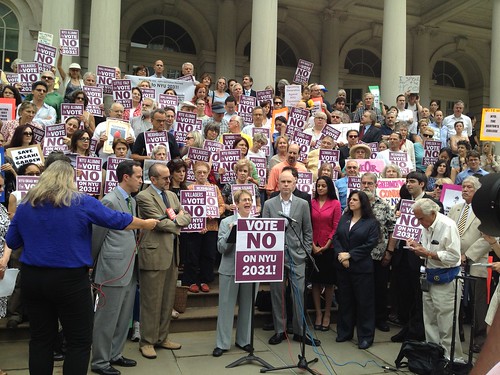 Sarah DarvilleProtesters on the steps of City Hall this morning.
Sarah DarvilleProtesters on the steps of City Hall this morning.The protesters have arrived in full force at City Hall, and so has Mayor Bloomberg and Matthew Broderick: it’s time to settle in for the City Council hearing on N.Y.U. 2031 – the final one before council members vote on the fate of the school’s expansion plan in Greenwich Village. Follow us on Twitter or stay parked right here as we update in real-time from what is sure to be a marathon meeting. If there’s a lull in the action and you want to brush up on what all this hoopla is about, you can review our Expansion Explainers. Otherwise, without further ado…
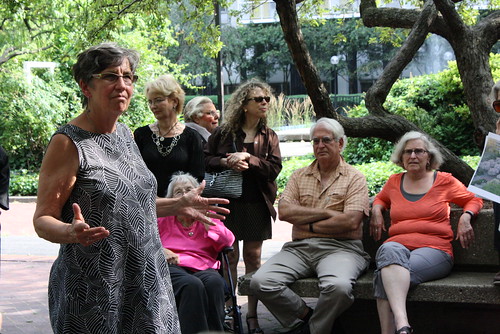 Sarah Darville Donna Schaper, Senior Minister of Judson Memorial Church, at left.
Sarah Darville Donna Schaper, Senior Minister of Judson Memorial Church, at left.Local residents and N.Y.U. faculty members gathered this evening in a garden that will be demolished if the university’s expansion plan is approved. During a mock funeral scheduled a day before a critical City Council hearing about N.Y.U. 2031, they lamented the loss of trees and the displacement of wildlife due to construction, and shared memories of a leafy retreat where they had meditated and played with their children.
Tucked between the two towers of the Washington Square Village superblock, Sasaki Garden has a low profile in the neighborhood. That lends itself to peace and quiet, neighbors said — but it also makes their fight to save the park more difficult.
Jan Blustein, professor of health policy and medicine at N.Y.U., was saddened at the prospect of the destruction of what she said had been a “beloved resource” for her and her family. “I had such a great experience living here and being a young faculty member here, and I’d hate for faculty to not have that opportunity in the future,” she said. Read more…
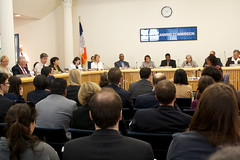 Sarah Darville The City Planning Commission.
Sarah Darville The City Planning Commission.New York University reined in its expansion plans further today by eliminating a controversial hotel and accommodations for retail, paving the way for an easy approval from the City Planning Commission.
“The N.Y.U. proposal for the superblocks will provide important new and needed space to one of the city’s most important institutions of higher learning,” said commission chair Amanda Burden, referring to the two blocks south of Washington Square Park that will be the sites of construction.
The green light from the commission did not come as a surprise — Ms. Burden had praised the plan just last week. Only one of the 13 members of the commission voted against the proposal. Read more…
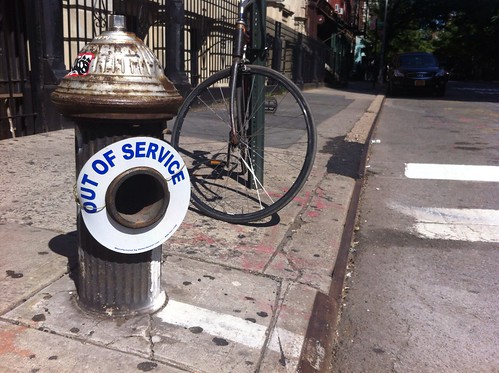 Suzanne Rozdeba
Suzanne RozdebaGood morning, East Village.
DNA Info attended the historical plaque ceremony at Justus Schwab’s former saloon on East First Street. The Greenwich Village Society for Historical Preservation, along with Phil Hartman of Two Boots, plan to install similar plaques at least once a year, and Mr. Hartman is hoping to commemorate the former home of Andy Warhol’s Exploding Plastic Inevitable at 19-25 St. Mark’s Place.
Speaking of Andy, The Times reviews “Jukebox Jackie,” based on the life of Warhol superstar Jackie Curtis. Charles Isherwood says that at times the new production at La MaMa “comes close to mimicking the foggy ramblings of someone on an intense trip,” but Justin Bond “most naturally embodies the Curtis who bloomed briefly before drug addiction felled him at the age of 38.”
The folks at the Lower East Side Preservation Initiative tell us that on Sunday at 1 p.m., theater historian Cezar Del Valle will lead a tour of the East Village’s Yiddish theater district, once known as the “Jewish Rialto.” As part of the tour, an architect involved in the restoration of Village East Cinema will talk about the theater that opened in 1926 as The Yiddish Art Theater. Tickets are $15 in advance and $20 on Sunday, and can be reserved here. Read more…
The conflicts over the future of two of the city’s most revered academic institutions rage on. Over in Greenwich Village, add Bloomberg’s architecture critic to the list of people not fond of N.Y.U.’s expansion plans. “For a while I thought these expressionless shapes were simply cartoon placeholders for real buildings that could be developed with a great deal more sensitivity,” reads the hard-hitting review. And over at Cooper Union, students have begun a petition drive in support of an alternative plan, dubbed “The Way Forward,” that suggests ways to raise revenue without charging students tuition.
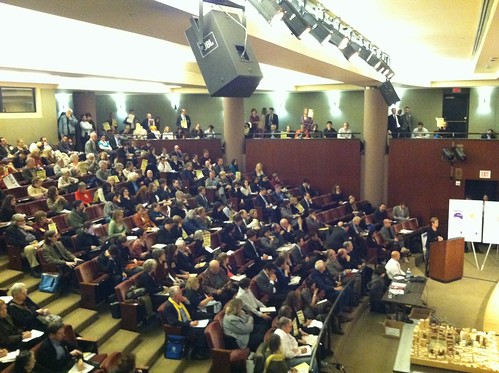 Natalie Rinn
Natalie RinnCritics and supporters of N.Y.U.’s planned expansion in Greenwich Village pleaded their cases before the New York City Planning Commission yesterday. The exchange was a critical one, since the controversial project must be approved by the Commission and then by the City Council before construction can begin.
For more than seven hours at the Smithsonian Museum of the American Indian, speakers gave three-minute testimonies in response to the university’s pending build-out of the school’s core campus south of Washington Square Park. With the museum’s stadium-style seating filled to capacity, President John Sexton faced hissing and intentional coughing as he explained why the university was in “desperate” need of additional space, and why so much of it needed to be located in Greenwich Village. Read more…
 Phillip Kalantzis-Cope
Phillip Kalantzis-Cope Good morning, East Village.
The Times looks back on what made Lakeside Lounge so special (“once, while Joey and Dee Dee Ramone played, audience members watched the police raid a nearby crack house and line suspects up against the picture window beside the stage”) and gives a clue as to why it’s closing at the end of the month: “[Owner Eric] Ambel said rent and expenses had more than quadrupled since the mid-1990s, forcing him and Mr. Marshall to face the prospect of deviating from the formula that had served Lakeside, its musicians and its patrons so well.” According to WNYC, the rent was $9,000 a month.
Flaming Pablum uses the closing of Lakeside as an excuse to look back on five other bygone dive bars, including Alcatraz on St. Marks Place, an “endearingly seedy joint that catered to acolytes of all things loud, boozy and rude.”
With the average rent in Manhattan at $3,418 a month and the vacancy rent at just 1 percent despite the lagging economy, The Times lays down some real talk: “For those who find buying a home in New York City is not an option — whether because of bad credit, tougher lending standards or lack of a down payment — the choices are limited and often unappealing.” If you are buying, the Daily News points out that there are still deals to be found in the Lower East Side. Read more…
A study commissioned by opponents of N.Y.U.’s expansion finds that the city’s economy would be better served if it were built outside of Greenwich Village. The report, released today by the Greenwich Village Society for Historic Preservation, states that the Financial District, Downtown Brooklyn and Long Island City could all better accommodate the amount of construction required for N.Y.U. 2031 while also reaping the benefits of the influx of students and scholars. The analysis comes only weeks after the Greenwich Village-Chelsea Chamber Commerce released its own study highlighting the economic benefits of the expansion in Greenwich Village, as well as its support among local merchants.
 N.Y.U. A rendering of the original plan.
N.Y.U. A rendering of the original plan.N.Y.U. announced today that, after negotiations with Manhattan Borough President Scott M. Stringer, it had agreed to reduce its ambitious expansion plans on two blocks south of Washington Square Park by nearly a fifth.
The revised plan includes significant changes for all four proposed buildings and the elimination of 377,000 square feet in the project, which originally called for 2,474,000 square feet of new space.
The new plan “strikes a balance between a great university’s need to grow and the importance of preserving Greenwich Village’s distinctive, historic character,” Mr. Stringer said in a press release. “There was nothing easy about this: Everyone had to give up something. No one got everything they wanted.”
The project, dubbed N.Y.U. 2031, will now go before the City Planning Commission and then the City Council. Community Board 2 voted unanimously to oppose the plan in February. Read more…
The Times reports that N.Y.U. has agreed to scale back its proposed expansion on two blocks south of Washington Square Park by roughly 16 percent after negotiations with the Manhattan borough president, Scott M. Stringer. The original plan called for 2,275,000 square feet of construction; the revised one reduces that number by 370,000 square feet. According to The Times, a 14-story building planned for the southern block will now be seven stories. The two buildings on the northern block will be “slimmed and shortened,” and the Zipper building will be further set back from Mercer Street. The plan must still be approved by the City Planning Commission and the City Council.
To conclude our week-long look at the impacts of N.Y.U.’s expansion plans, The Local examines the concerns surrounding loss of light under the proposed development.
Q.
How will the new buildings proposed on the two superblocks south of Washington Square Park affect sunlight in the area?
A.
There’s no getting around it, the new buildings mean less light. The LaGuardia and Mercer buildings planned for the north block will cast shadows on the two Washington Square Village buildings. More controversially, the proposed Bleecker building on the south block will cast a shadow that likely means an end to the LaGuardia Corner Gardens, located in front of the Morton Williams supermarket on a strip of property that belongs to the Transportation Department. The university notes that the alignment of the LaGuardia and Mercer buildings would make the block resemble the dimensions of the city’s grid pattern – “not an unusual New York City condition,” per William Haas, the university’s director of planning. Read more…
As Village residents await Borough President Scott Stringer’s recommendation early next month regarding N.Y.U.’s expansion plans, The Local is taking a look at the impacts of the project. Today, we’re examining the concerns surrounding the replacement of a dog run under the proposed development. Yesterday, we looked at the impact the proposal would have on three playgrounds in Greenwich Village. Check back for our coverage of concerns surrounding loss of light and the LaGuardia Community Garden.
Q.
So what does the future hold for the dog run at the corner of Houston and Mercer Streets should N.Y.U.’s expansion be approved?
A.
 N.Y.U. The proposed dog run.
N.Y.U. The proposed dog run.The dogs and their roughly 300 owners at the Mercer-Houston Dog Run will have to be relocated to make way for the Zipper building, which will be 26 stories at its highest point. The building would extend almost the entire length of the south block along Mercer Street between Houston and Bleecker Streets. In addition to housing, academic, retail space and a hotel, the new structure would also hold the replacement for the Morton Williams Supermarket at the northwest corner of the south block. The university says the replacement grocery store would be fully operational before Morton Williams is demolished in 2018. Read more…
As Village residents await Borough President Scott Stringer’s recommendation early next month regarding N.Y.U.’s expansion plans, The Local is taking a look at the impacts of the project. Today, we’re examining the concerns surrounding the replacement of four playgrounds under the proposed development. Yesterday, we looked at the impact the proposal would have on parking in Greenwich Village. Check back for our coverage of concerns surrounding loss of light, the dog run, and the LaGuardia Community Garden.
Q.
If N.Y.U.’s expansion is approved, what will happen to the playgrounds in its footprint?
A.
There are three playgrounds on the two blocks where N.Y.U. is seeking to build. They are Mercer Playground, located along Mercer Street on the north block; Key Park, which is just west of Mercer Playground between the two buildings in Washington Square Village; and Rocket Ship Park on the south block. Each one will be demolished and eventually replaced. N.Y.U. says that at a minimum, a temporary playground will always be open during the proposed 20-year buildout. Key Park and Rocket Ship Park are not open to the public — the replacement parks will be public. Read more…
As Village residents await Borough President Scott Stringer’s recommendation early next month regarding N.Y.U.’s expansion plans, The Local is taking a look at the impacts of the project. Today, we’re examining the concerns surrounding parking under the proposed development. Check back throughout the week for our coverage of concerns surrounding loss of light, the dog run, playgrounds, and the LaGuardia Community Garden. What other issues should we tackle? Let us know in the comments.
Q.
OK, so how is parking in Greenwich Village going to be affected by this plan?
A.
Currently, there are 670 spaces in a garage underneath Washington Square Village. Of these, 150 are public and the rest, a total of 520, are reserved for residents and their guests. As proposed, 281 parking spaces will be permanently eliminated. No spaces will be available to the general public.
Q.
So, 281 lost? That sounds like a lot.
A.
The new garage would have 389 total spaces, which is the minimum required by the city zoning code. The entirely private garage would be built starting in 2022 and would be accessible through only one entrance, whereas the existing one has two (on West Third and Bleecker Streets). The current garage operates at around 80-percent capacity, and has around 130 spaces available on a typical workday. N.Y.U. believes that the amount of traffic using the new garage will be significantly less than it is now, given that the lot will not be open to drivers regularly commuting into the area. Opponents like Terri Cude, co-chairwoman of the Community Action Alliance, argue that the single entrance and exit would create a choke point that would exacerbate traffic. Read more…

















